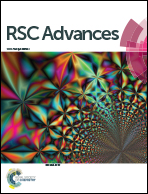Point defect interactions in iron lattice: a first-principles study
Abstract
The interaction of point defects (interstitial atoms and vacancy) in both BCC Fe and FCC Fe lattices were investigated by first-principles calculations. The goals were to find the equilibrium separation of two interstitial atoms in the iron lattice and to establish the maximum trapping capacity of a mono-vacancy in the iron lattice. Based on our study, the equilibrium separation values of C–C, B–B and C–B were about 5.31 Å in the BCC Fe lattice. In the FCC Fe lattice, the equilibrium separation of C–C, B–B and C–B was about 6.42 Å. A mono-vacancy is shown to be capable of steady trapping as many as 3 atoms to form VXn (X = C/B, n = 0, 1, 2, and 3) and VCB, VC2B and VCB2 complexes in the BCC Fe lattice. For the FCC Fe lattice, it is energetically favorable for a mono-vacancy to accommodate 2 C atoms, 3 B atoms, 2 C atoms and 1 B atoms, 1 C atoms and 2 B atoms, and 1 C atoms and 3 B atoms to form VC2, VB3, VC2B, VCB2 and VCB3 clusters, respectively. However, when four interstitial atoms are in the same plane and occupy the nearest interstitial sites around the vacancy, they can also form VC4, VB4, VC2B2 and VCB3 in the BCC Fe lattice and VB4 and VC2B2 in the FCC Fe lattice. Moreover, we also found that the trapping ability of a vacancy is stronger in BCC Fe than in FCC Fe. These results are in good agreement with the available calculations and experiments results.


 Please wait while we load your content...
Please wait while we load your content...